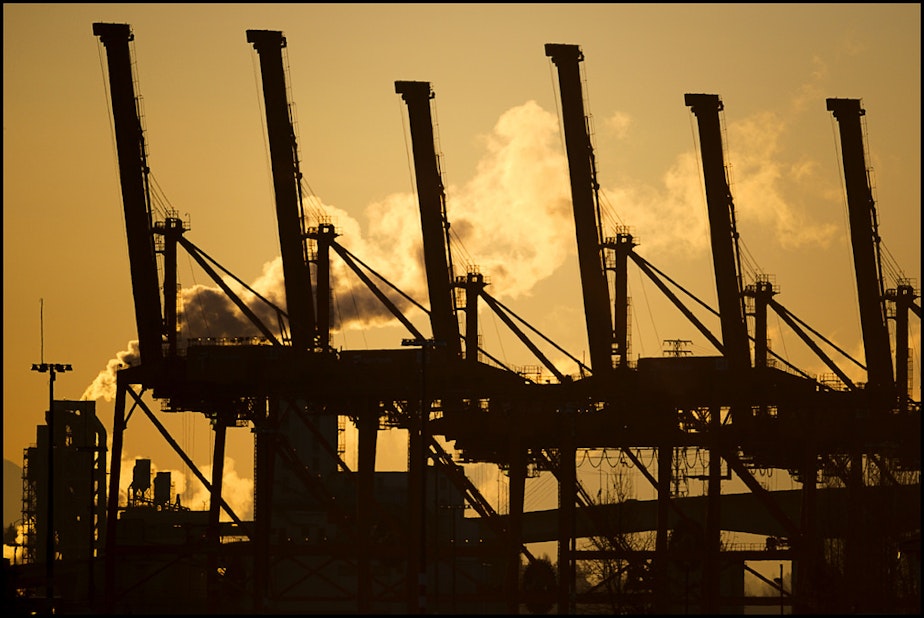Our ports are polluting less, but don’t throw a party yet

The ships, trains and trucks that haul cargo around Puget Sound are pumping out less of the soot, sulfur dioxide and other things you don’t want to breathe.
Air pollution from the ports of Seattle and Tacoma has dropped over the past decade, according to long-term monitoring released by the ports Thursday.
“The 2016 data shows a dramatic reduction in sulfur emissions and particulate matter,” Sara Cederberg, who works on air pollution for the two ports’ Northwest Seaport Alliance.
Monitoring conducted for the Puget Sound Maritime Air Forum, a mix of government and corporate players in the maritime sector, found that nitrogen oxides and volatile organic compounds both dropped by more than 20 percent since 2005. Soot of various kinds, including the smallest particles that can lodge deepest in human lungs, dropped by about 70 percent. Sulfur dioxide, which can worsen asthma and cardiovascular disease, dropped 97 percent.
All ships in U.S. and Canadian waters have been required to use low-sulfur fuel for the past three years. Cederberg said local efforts, both voluntary and regulatory, to clean up the trucks and machinery have also helped keep pollutants out of the air. About half of the 4,500 trucks that unload goods from Puget Sound ports meet the ports’ new clean-air standards, according to Cederberg.
Sponsored
Some of the remaining truckers, many of whom are low-income immigrants, have complained they can’t afford to replace their old rigs. In February, the ports gave truckers an extra year to make the switch — pushing back a deadline set a decade earlier to lessen the harm that truck exhaust does to surrounding communities' health.
Truckers who had already invested in cleaner rigs said delays put them at a competitive disadvantage. “The Port of Tacoma dropped the ball. So that’s the issue, so now we have this mess,” Ian Collins with the Washington Trucking Associations told the News Tribune in December.
The ports have also established a $2.2 million revolving loan fund to help drivers with poor credit histories afford cleaner trucks.
On Wednesday, Gov. Jay Inslee signed a bill to allow ports to spend money on equipment and programs that reduce pollution from privately owned trucks and ships that use their facilities.
Little progress on the biggest pollutant
Sponsored
The ports’ biggest (by tonnage) and arguably most dangerous pollutant hasn’t declined much. Emissions of carbon dioxide, which is heating the whole planet with potentially dire consequences, hovered around 1.5 million tons a year. CO2 emissions dropped 10 percent from 2005 to 2011, then just 1 percent in the following five years.
The ports’ study said carbon dioxide dipped for a simple reason: The amount of cargo handled by the port has dipped as well. Both Seattle and Tacoma are expecting major growth at their ports, with carbon dioxide also expected to go up.
The port only looks at pollution in the “airshed” of Puget Sound — from the inland sea to the crests of the Cascades and Olympics.
“We’re really looking at what we can control within our own geography,” Cederberg said.
Clean-air rules don’t apply once ships are 200 miles offshore. Then ships can switch over to dirtier fuel for the remaining 90 percent of the long voyage to Asia.
Sponsored
Two years from now, the big cargo ships will have to use low-sulfur fuel wherever they go, Cederberg said.
Shipping and aviation were the two major sectors of the world economy not addressed by the 2015 Paris climate agreement. The sectors' pollution is expected to worsen globally as more people and stuff move around the world.
Last year, the ports of Seattle and Tacoma announced they would cut their greenhouse gas emissions in line with the Paris agreement.
Cederberg said her team is currently figuring out how to do that.

